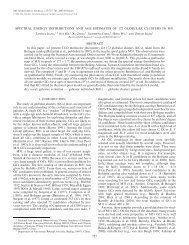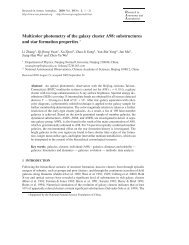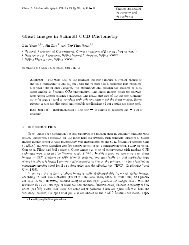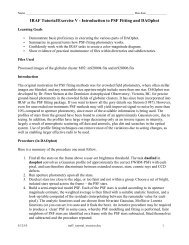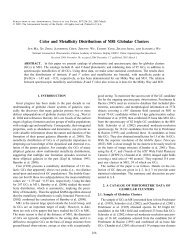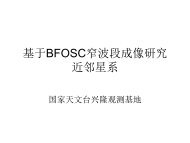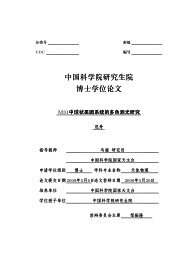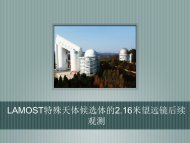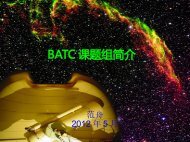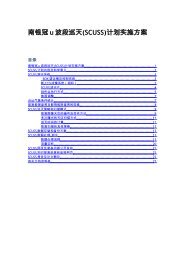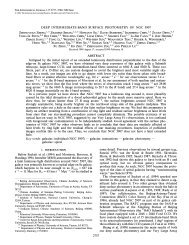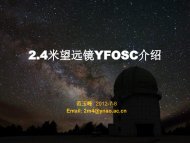Wen,Z.L.,Yang,Y.B.,Zhou,X.,Yuan,Q.R.,Ma,J ... - BATC home page
Wen,Z.L.,Yang,Y.B.,Zhou,X.,Yuan,Q.R.,Ma,J ... - BATC home page
Wen,Z.L.,Yang,Y.B.,Zhou,X.,Yuan,Q.R.,Ma,J ... - BATC home page
Create successful ePaper yourself
Turn your PDF publications into a flip-book with our unique Google optimized e-Paper software.
522 Z. L. <strong>Wen</strong>, Y. B. <strong>Yang</strong>, X. <strong>Zhou</strong> et al.<br />
QSOs. With radio-selected QSOs, positive correlations have been found (Seldner & Peebles 1979; Chu &<br />
Zhu 1984; Fugmann 1988, 1990; Bartelmann & Schneider 1994; Bartsch et al. 1997; Norman & Impey<br />
1999, 2001). With optical-selected QSOs, positive (Williams & Irwin 1998), negative (Boyle et al. 1988;<br />
Benítez et al. 2001), and null (<strong>Ma</strong>rtínez et al. 1999) correlations were found. Recently, Gaztañaga (2003)<br />
reported a positive galaxy-QSO cross-correlation using bright QSOs (i ′ < 18.8) from the SDSS QSO spectroscopic<br />
survey. Myers et al. (2003, 2005) detected negative correlations between 23 000 2QZ QSOs and<br />
foreground galaxies/clusters. Scranton et al. (2005), for the first time, detected positive, negative and null<br />
correlations in their analysis with SDSS 3800 deg 2 photometric data containing ∼ 200 000 QSOs and 13<br />
million galaxies.<br />
Although these results are in qualitative agreement with the gravitational lensing effect, in most cases<br />
the amplitude of observed correlation is much higher than the theoretical prediction. Webster et al. (1988),<br />
Rodrigues-Williams & Hogan (1994), Williams & Irwin 1998, and Gaztañaga (2003) found positive correlations<br />
that are much stronger than the predictions. Croom & Shanks (1999) reanalyzed the result of Boyle<br />
et al. (1988) in term of gravitational lensing, showing that the amplitude requires the velocity dispersion<br />
in clusters to be 1286 km s −1 , much higher than expected for the detected clusters. Similar problem also<br />
exists in Myers et al. (2003). Effort has been made to explain these disagreements. Wu & Fang (1996) considered<br />
environmental mass around the clusters, but contribution from environment remains insufficient to<br />
account for the observed correlations. Scranton et al. (2005) pointed out that the discrepancy is possibly due<br />
to systematic effects in the datasets. For example, the QSO sample is 20% contaminated by Galactic stars<br />
in Boyle et al. (1988), and the 2dF QSO survey is found to be less complete beyond b J =20.2 (Richards et<br />
al. 2005). However, how much these factors affect the result is still not very clear. In this paper, we address<br />
the question utilizing an unprecedented cluster sample and more complete QSO sample from the SDSS.<br />
This paper is organized as follows: In Section 2 we describe the galaxy cluster selection algorithm. In<br />
Section 3 we describe the QSO sample used in this paper. In Section 4 we measure the two point angular<br />
cross-correlation function between the clusters and QSOs, and model the clusters as Singular Isothermal<br />
Spheres and NFW profile halos. We give a discussion in Section 5 and our conclusions in Section 6.<br />
Throughout this paper we adopt the ΛCDM cosmology model with h = H 0 /100 km s −1 Mpc −1 =0.75,<br />
Ω m =0.3 and Ω Λ =0.7.<br />
2 GALAXY CLUSTER SELECTION<br />
The Sloan Digital Sky Survey is a wide-field photometric and spectroscopic survey. It will provide five<br />
broad bands (u ′ , g ′ , r ′ , i ′ and z ′ ) photometry over 10000 deg 2 and follow-up spectroscopy of 10 6 galaxies<br />
(http://www.sdss.org). The spectroscopic galaxy survey observes galaxies with extinction-corrected<br />
Petrosian magnitude r ′ < 17.77 for the main sample (Strauss et al. 2002) and r ′ < 19.5 for the luminous<br />
red galaxy (LRG) sample (Eisenstein et al. 2001).<br />
The galaxy sample is taken from SDSS DR4. With the five-band photometry, we estimate the photometric<br />
redshifts of galaxies down to r ′ =21using the technique of <strong>Yang</strong> et al. (2005). The algorithm can<br />
provide the photometric redshifts of galaxies with uncertainty σ z ∼ 0.03, on which we base to present<br />
galaxy cluster selection. The method of selection is similar to the classical one of Abell (1958) who selected<br />
clusters by counting the numbers of galaxies. With the photometric redshifts, we can count the numbers<br />
within a proper radius, excluding foreground and background galaxies. First, we select a sample of<br />
LRGs brighter than M r ′ = −22 as cluster galaxy candidates. This is because LRGs have more precise<br />
photometric redshifts and they are more likely to be in the clusters. We note that spectroscopic redshifts<br />
are adopted as long as they are available and we apply the k-correction following Fukugita et al. (1995).<br />
Secondly, for each candidate at redshift z, we count the numbers of galaxies N within 0.5 h −1 Mpc and<br />
z ± 0.05 based on the photometric redshifts. Thirdly, defining the density contrast of the environment of the<br />
LRG as δ = N/〈N〉−1, where 〈N〉 is the mean counts with the same range at z, candidates with δ>2<br />
are identified as cluster galaxies. Center of cluster is defined by the position of the LRG with the highest<br />
density contrast within 1 h −1 Mpc and z ± 0.05, and the cluster redshift, by that of the central LRG. At<br />
high redshift, the mean density of galaxies is low, and a few counts could give a high ensity contrast. Some<br />
of these galaxies may not lie in the clusters. To reduce false selection, we eliminate those candidates with




